NVIDIA's GeForce GT 430: The Next HTPC King?
by Ryan Smith & Ganesh T S on October 11, 2010 9:00 AM ESTPower, Temperature, & Noise
We only have 1 GT 430 card on hand, so unlike past articles we cannot compile any data on the load voltages of this line of cards. Our lone Asus card has a load voltage of 1.08v, and an idle voltage of 0.88v. Idle clocks are 50.6MHz for the core, and 270MHz effective for the memory.
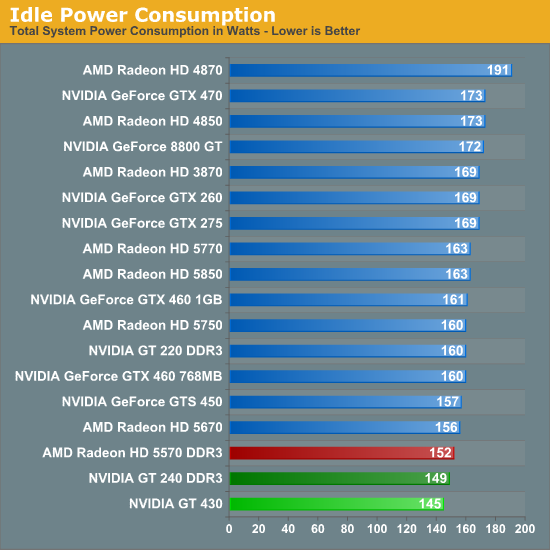
While GT 430 may not be competitive on a performance-per-dollar basis, it’s hard to argue with these power results. Even at these low wattages where our 1200W power supply isn’t very efficient, the GT 430 still delivers an idle power consumption level 7W under the Radeon 5570, and an even larger 11W advantage over the otherwise performance-superior Radeon 5670. We can’t measure the card’s actual power consumption and NVIDIA does not provide a reference level, but the GT 430 can’t be drawing more than a couple of watts here.
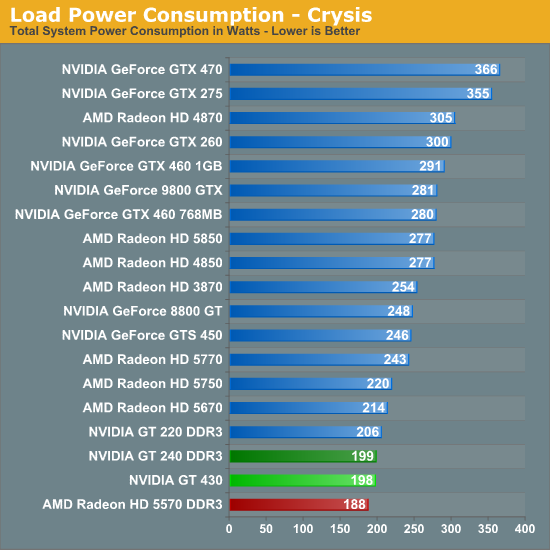
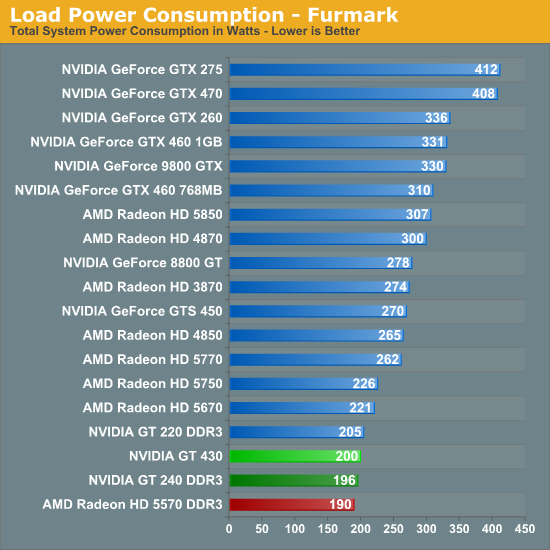
Under load things are less rosy for the GT 430. Under Crysis it ends up drawing 10W over the 5570, which serves as yet another testament to the amazing level of performance-per-watt that AMD has been able to attain; remember that the 5570 had better performance at the same time. Under Furmark the situation is just as bad, but at this point we’re looking at a more pathological case. Overall 10W isn’t going to break the bank in an HTPC (especially since these cards would rarely get up to full clocks in the first place) but it’s something to consider if every watt is going to count.
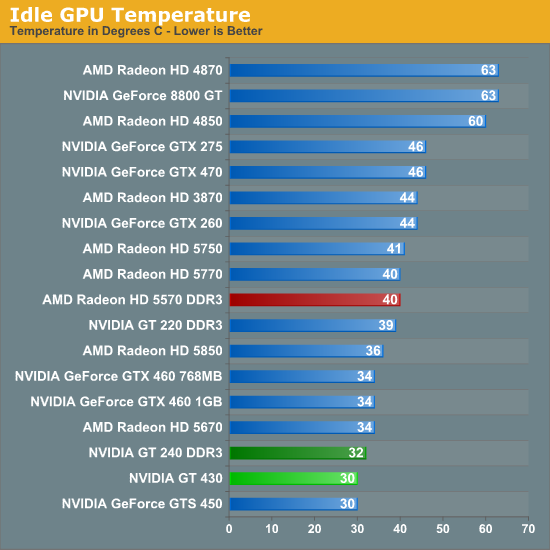
When it comes to idle temperatures, the GT 430 is second to none. With the card only consuming a couple of watts at idle in the first place, its idle temperatures are barely above room temperature (and even closer to ambient case temperatures). It’s tied with the GTS 450, which impressed us last month with its highly capable cooler. Meanwhile our 5570, which is a low-profile card just like the GT 430, ends up being a good 10C higher. AMD’s higher idle power consumption directly translates to a higher idle temperature.
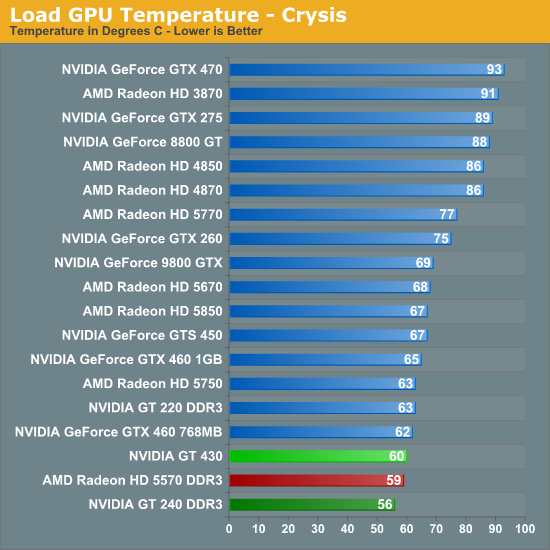
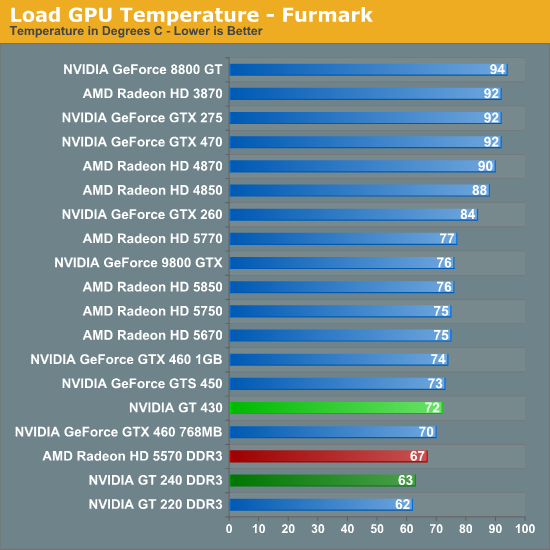
Looking at load temperatures, these results aren’t all that surprising given the cooler in use. The Asus cooler is practically a passive cooler, as the small fan is not capable of moving much air (though it is unusual to not see Asus aggressive on cooling). As a result it manages to reach higher temperatures, but we’re still only talking about 60C under Crysis and 72C under Furmark. This is worse than the 5570 and its larger fan by a bit, but not significantly so.
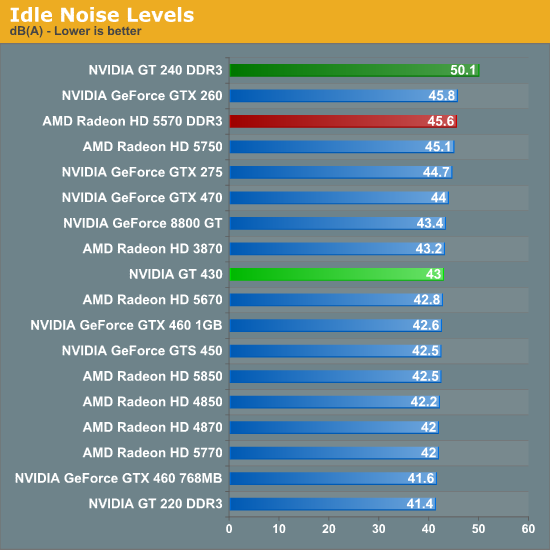
At idle the GT 430 is consistent with our other cards. With the exception of a couple ridiculous cards like our GT 240 and in this case the 5570, everything is at roughly 42-44dB(A). The 5570 is more fan than heatsink, which is likely why it has such a poor showing here compared to the GT 430.
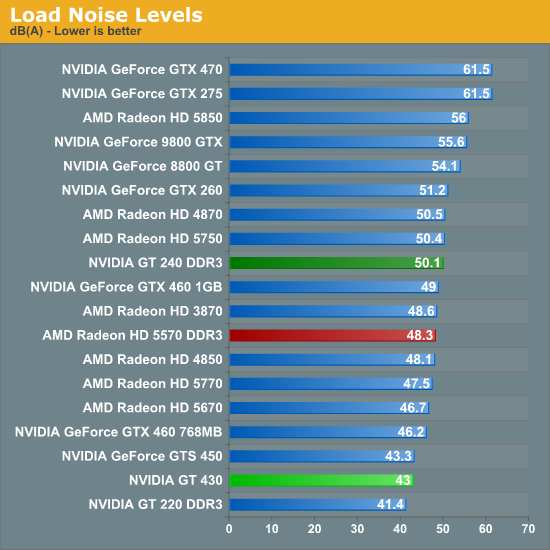
The payoff of accepting higher temperatures is less noise to contend with. The GT 430 never needs to ramp up its fan in our tests, delivering a load noise level even lower than the GTS 450, and only worse than a GT 220 that runs up against ambient noise levels. If you want to make a good HTPC card then it needs to be silent, and Asus/NVIDIA have delivered on that here. It’s not quite silent since it’s not passive, but it’s about as close as one can reasonably achieve. It’s also noticeably better than the 5570, a card which is by no means noisy. If noise is a primary concern then the GT 430 is a very good candidate for a HTPC.










120 Comments
View All Comments
Ryan Smith - Monday, October 11, 2010 - link
None of the good product shots I have include passive GT 430s. However there are 2 in the collage on an NV slide: a Sparkle and a Zotac.ranger203 - Monday, October 11, 2010 - link
I have a Geforce G210 for my media center and it runs blu-rays well. I am looking for a little more umpppff to allow some post processing of other videos. But I paid $35 for my card, and the only way I would replace it was if this one was under $50.But.... a quick froogle search found they want to go for around $75. Giga-byte offers a passive cooler, looks pretty bad ass.
http://www.provantage.com/gigabyte-technology-gv-n...
Lolimaster - Monday, October 11, 2010 - link
Just buy a HD5550. You shoul've started buying an AMD IGP Mobo, that's enough.Nvidia on the low end is just worthless.
DMisner - Monday, October 11, 2010 - link
I noticed it has the same number of CUDA cores as the GT 240. Would this perform any better or about the same as the GT 240 for Folding@Home?AznBoi36 - Monday, October 11, 2010 - link
It's slower than the GT240. Also the GT240 is a full height card, while this one is low profile. There is a reason why this card is called the GT430 and not a GT440.mczak - Monday, October 11, 2010 - link
Hmm on page 1 it says roughly same die size as "Juniper GPU in the 5500/5600 families" - that should be redwood. Also, the "GT430 goes up against... GT430..." I guess that should be GT240?I'm really wondering how they attach 4 rops to two memory partitions btw. I believe that one quad rop per partition wouldn't really have required a lot of changes over one octo-rop per partition, but either the quad-rop block was split into 2 or it's actually attached to both MCs. Of course, for actual color fillrate, it doesn't really matter if there are 4 or 8 rops - pixel output is limited to 2 per SM anyway.
jsbiggs - Monday, October 11, 2010 - link
Additional correction:On the Power, Temperature, and Noise page, the line "Even at these low wattages where our 1200W power supply isn’t very efficiency". Probably should be "...isn't very efficient". Cheers.
Onferno - Monday, October 11, 2010 - link
Passively cooled and working as a PhysX card:http://www.hardwareheaven.com/reviews/1046/pg10/zo...
kmitty - Monday, October 11, 2010 - link
Depends on your definition of 'ultimate'. For me, just looking at it and seeing a fan meant it wasn't my ultimate HTPC card - absolute silence required!mcnabney - Tuesday, October 12, 2010 - link
No kidding.An ideal HTPC card is:
1. Silent
2. Consumes very little power
3. Can decode all current and pending video format/containers
4. Fits half-height as well
5. Has rock-solid driver support
6. Cheap
7. Bitstream audio and includes a full version of BluRay software to support it
This card just doesn't measure up. Ideally the best HTPC card isn't a card, but is actually part of the motherboard.